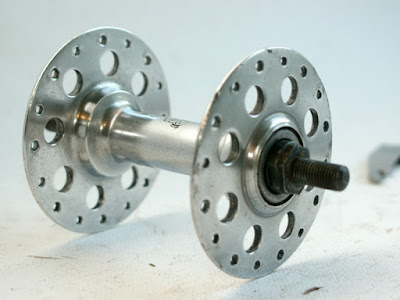Over the past decades, the number of gears on road bikes has steadily increased. Current groupsets now provide up to 22 gear combinations produced by two front chainrings and 11 rear cogs. To get the most out of your gears, it serves to pay attention to the gear ratios produced by the combination of the chainrings with the rear cassette and tailoring them to suit your riding needs.
A road groupset can offer a variety of gear ratios ranging from about 1.21 to 4.81 in increments of 0.15-0.40. Rather than trying to understand the significance of gear ratios directly, they can be transformed into more meaningful values in one of two ways.
The first method is to relate the gear ratio to wheel size by multiplying the gear ratio by the diameter of the wheel. The resulting value, gear inches, provides the diameter of a wheel that has a circumference equivalent to the distance a geared bike will travel with one turn of the cranks and the chosen gear ratio.
The second method, meters of development, is calculated by multiplying the gear ratio by the circumference of the wheel. The resulting value, meters of development, provides the meters a wheel will travel with one turn of the cranks and the choosen gear ratio.
In practice, road riders typically don’t pay much attention to gear ratios due to the abundance of choices available to them. However, there is still considerable value in fine-tuning the range of gear ratios at your disposal to maximise their utility.
So far for the theory as understood today and back to the classic lightweight stuff:
Do you remember Half-Step?
Well, it is a ratio formula where the average of the percentage of difference between your rear cogs is calculated, and your largest two chainrings are set up to provide half the average percentage of the rear. This provides two interlaced gear ranges and eliminates duplicate gears so commonly found on cranksets that have 10 tooth jumps between the large rings. It was used when front derailleurs could only handle a small step between chainrings and when rear cogsets only had a small number of sprockets.
There are some downsides to half-step; not many, but some.
First, you should get rid of your indexed shifting at the front derailleur, because half-step gearing with 6 or more sprockets creates a situation in which chainline is not straight and the chain might be deflected at too great an angle. But if you need indexing you are probably at the wrong site
Second it is also necessary to set your front derailleur slightly higher than factory specs
Third to step sequentially through the gear ratios requires a simultaneous front and rear shift on every other gear change. This style is not available off the shelf.
A variation of Half-step is called half-step with granny in which three chainrings with half-step differences between the larger two and multi-range differences between the smaller two are paired with a cogset modified for half-step gearing. This general arrangement is suitable for touring with most gear changes being made using the rear derailleur and occasional fine tuning using the two large chainrings. The small chainring called the granny gear is a bailout for handling steeper hills, This style is not available off the shelf also.
But please be aware that besides gearing performance is also affected by rolling resistance and air resistance. Rolling resistance can vary by a factor of 10 or more depending on type and dimensions of tire and the tire pressure and air resistance increases greatly and most significantly as speed increases.
How to individually update your freewheel and sprockets?
First you need to know whether single sprockets are available and interchangeable on your brands freewheel. Second you need to know the mounitng methodology of your freewheel. Both differs from brand to brand.
For those brands mentioned in the table above sprockets are interchangeable but are no longer in production and might not be offered very often. Thus you need to observe those portals in which old bicycle stuff is offered.
In order understand what sprocket terminology you will find with the Maillard brand and which ones you might be able to change to the highly sought after alloy/ dural or sometimes also called zyrcal version please have a look on the following pictures
As you can see those rare dural sprockets will only fit on 5 up to 6 speed freewheel bodies officially but might be used also to update any compact 6 or speed freewheel with exeption of the completion sprockets MC) that needs to be of the steel type but will reduce the freewheels weight still a lot.
Happy sprocket switching!




























































